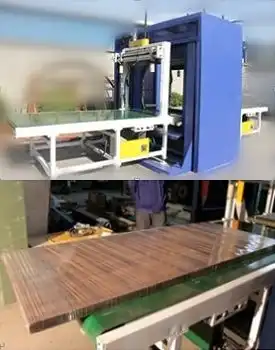Optimizing Door Packaging Operations with Cardboard Box Machinery
Handling and packaging finished doors presents unique challenges in manufacturing and logistics. Doors are often bulky, relatively heavy, and susceptible to surface damage during transit. Utilizing automated solutions like a cardboard box door packing machine offers an efficient method to protect these products securely and prepare them for shipping.
This type of packaging machinery is engineered specifically for the demands of door packaging, providing a consistent and reliable process.
Key Operational Features and Benefits
Modern cardboard box door packing systems incorporate several features designed to enhance throughput and ensure product safety.
Enhanced Packaging Speed and Efficiency
Automated door packaging machines significantly increase packaging speed compared to manual methods.
- High Throughput: Designed for continuous operation, these machines can process a high volume of doors per shift, aligning with production line speeds.
- Reduced Labor Dependency: Automation minimizes the manual labor required for boxing, freeing up personnel for other tasks and reducing operational costs.
- Consistent Cycle Times: Automated processes ensure predictable packaging times for better production planning.
Ensuring Product Protection and Integrity
The primary goal is to deliver damage-free doors. These machines contribute by:
- Secure Boxing: Automatically forming or utilizing pre-formed cardboard boxes specifically sized for doors, ensuring a snug fit.
- Protective Material Integration: Options often exist to integrate supplementary protective materials, such as foam padding, edge protectors, or strapping mechanisms, directly into the packaging cycle for enhanced cushioning and stability.
- Gentle Handling: Mechanisms are designed to handle doors carefully, minimizing the risk of scratches or dents during the packaging process itself.

door packing machine1 Versatility for Diverse Door Specifications
Manufacturing lines often handle various door types. Adaptability is crucial:
- Size and Shape Accommodation: Many machines can be adjusted or are designed to handle a range of door dimensions (height, width, thickness) and styles (e.g., panel doors, flush doors, doors with glass inserts).
- Customizable Packaging Profiles: Settings can often be adjusted for different packaging requirements based on the door type or destination requirements.
User Interface and Operational Simplicity
Ease of use facilitates smoother integration and operation:
- Touch Screen Controls: Intuitive interfaces allow operators to set parameters, monitor the process, and manage different packaging recipes.
- Diagnostics and Alarms: Integrated systems often feature automatic alerts for material replenishment (e.g., cardboard blanks) or operational issues, minimizing downtime.
Integrating the Machine into the Production Line
Cardboard box door packing machines can operate in different modes:
- Manual Mode: Allows for operator intervention or handling specific, non-standard items.
- Automatic Mode: Enables fully automated operation, often integrated with upstream and downstream conveyor systems within a larger automatic packing line. This seamless flow maximizes efficiency from production finishing to warehouse or shipping.
Material Considerations and Cost Optimization
Effective packaging also involves managing material usage:
- Optimized Material Use: Automated systems are typically designed to use cardboard efficiently, potentially reducing waste compared to manual boxing.
- Reduced Damage Costs: By providing consistent and robust protection, these machines help lower the costs associated with replacing or repairing doors damaged during shipping and handling. Adhering to packaging standards, like those outlined by organizations such as the International Safe Transit Association (ISTA), further ensures transit robustness.

door shrinking machine with motion sealer5 Best Practices for Implementation and Maintenance
To maximize the benefits of a cardboard box door packing machine:
- Operator Training: Ensure personnel are properly trained on operation, safety procedures, and basic troubleshooting.
- Regular Maintenance: Follow the manufacturer's recommended maintenance schedule for cleaning, lubrication, and inspection of wear parts.
- Material Quality: Use appropriate grades of cardboard suited for the weight and type of doors being packaged.
- Safety Compliance: Adhere to all machine-specific safety protocols and lockout/tagout procedures during maintenance.
Conclusion
Automated cardboard box door packing machinery provides a systematic and efficient solution for preparing doors for transport and storage. By enhancing packaging speed, ensuring consistent product protection, offering operational flexibility, and potentially reducing material and labor costs, these systems play a vital role in streamlining logistics within the door manufacturing industry. Their ability to integrate into broader automated production lines further underscores their importance in modern manufacturing environments.